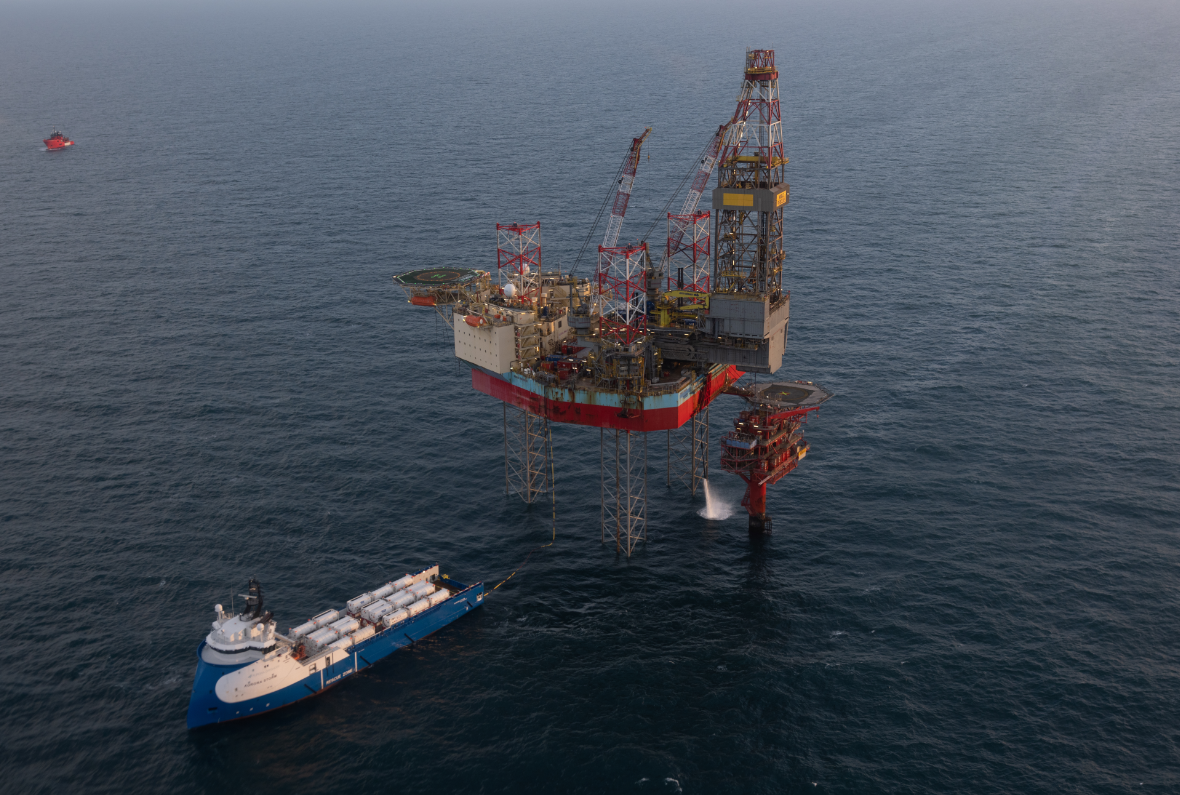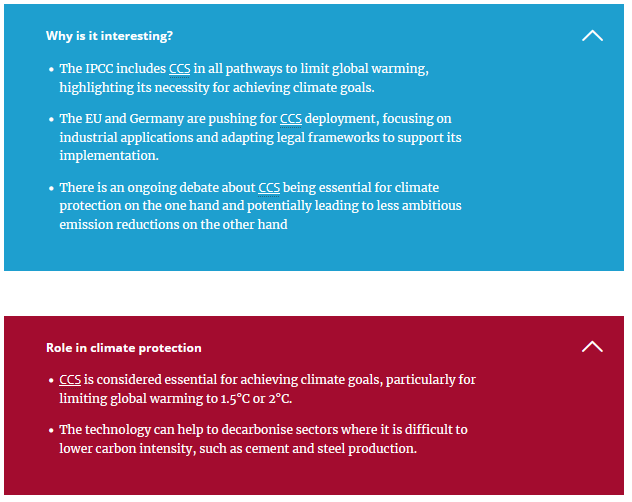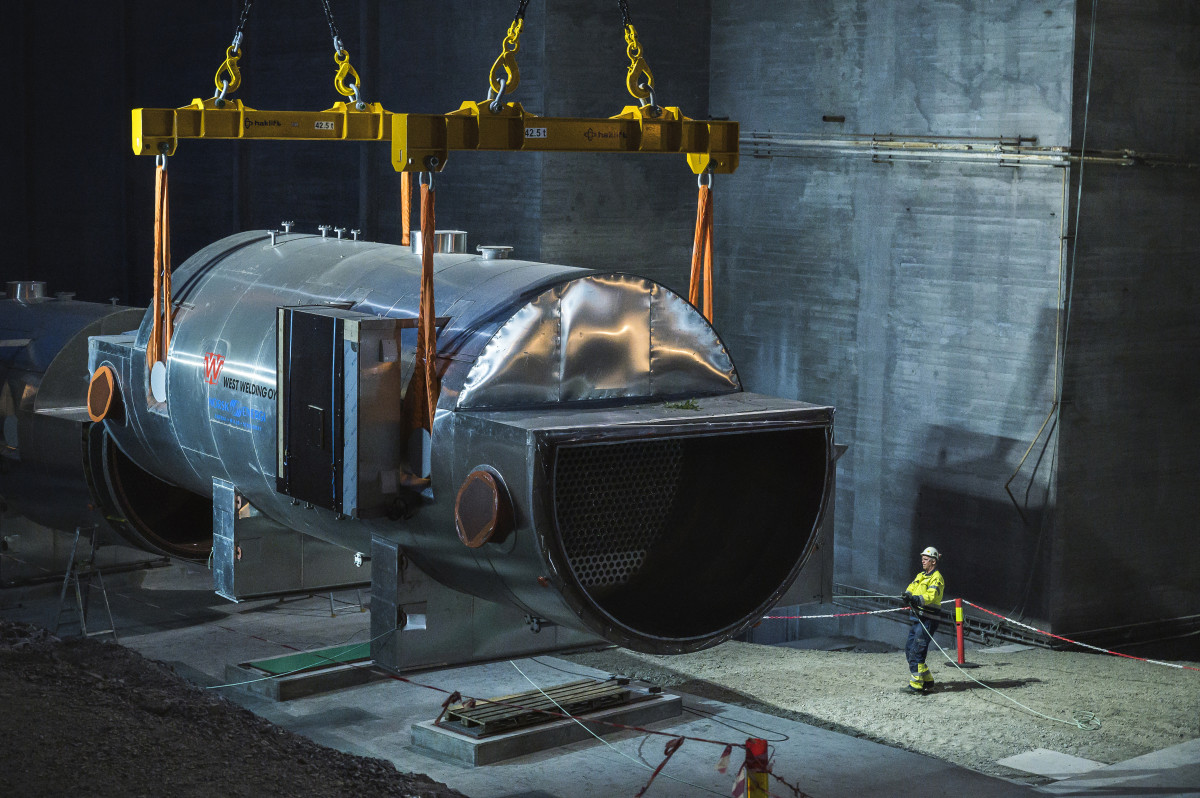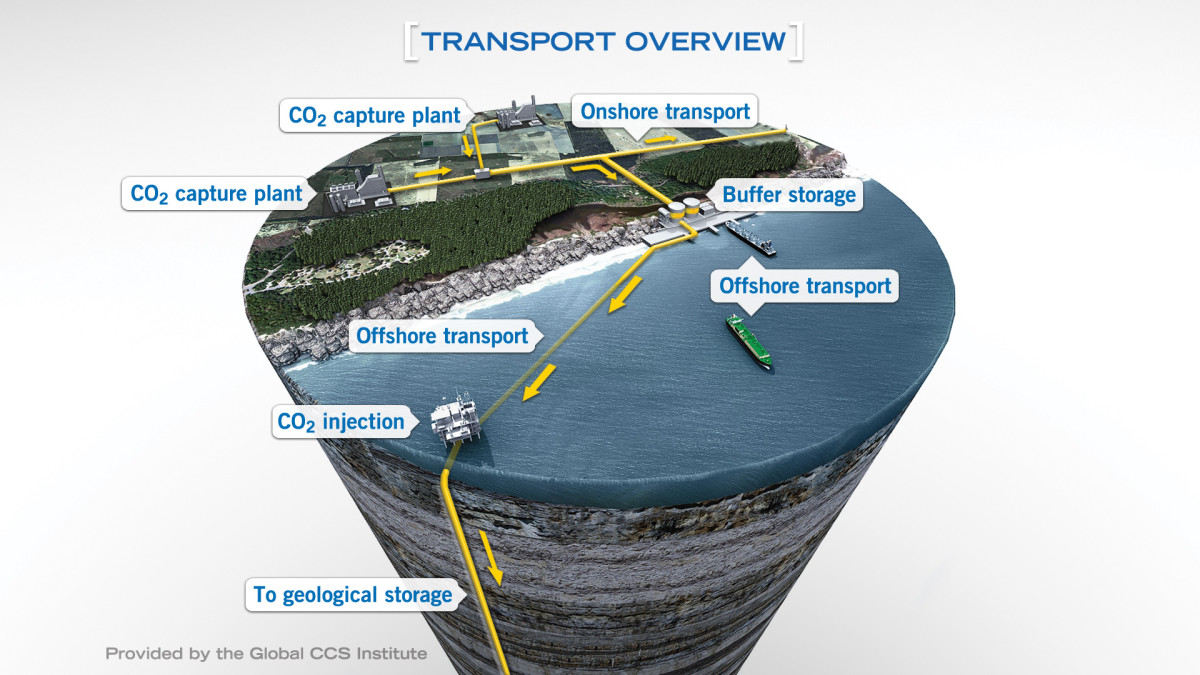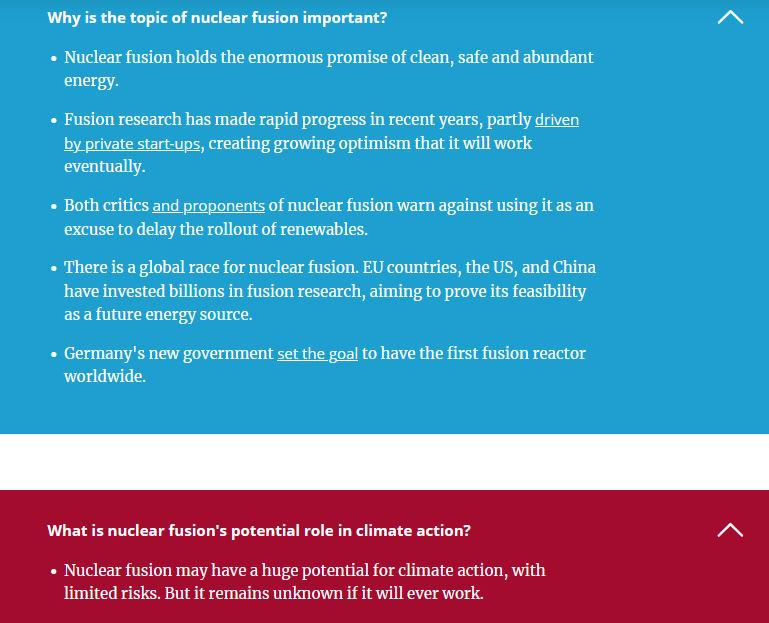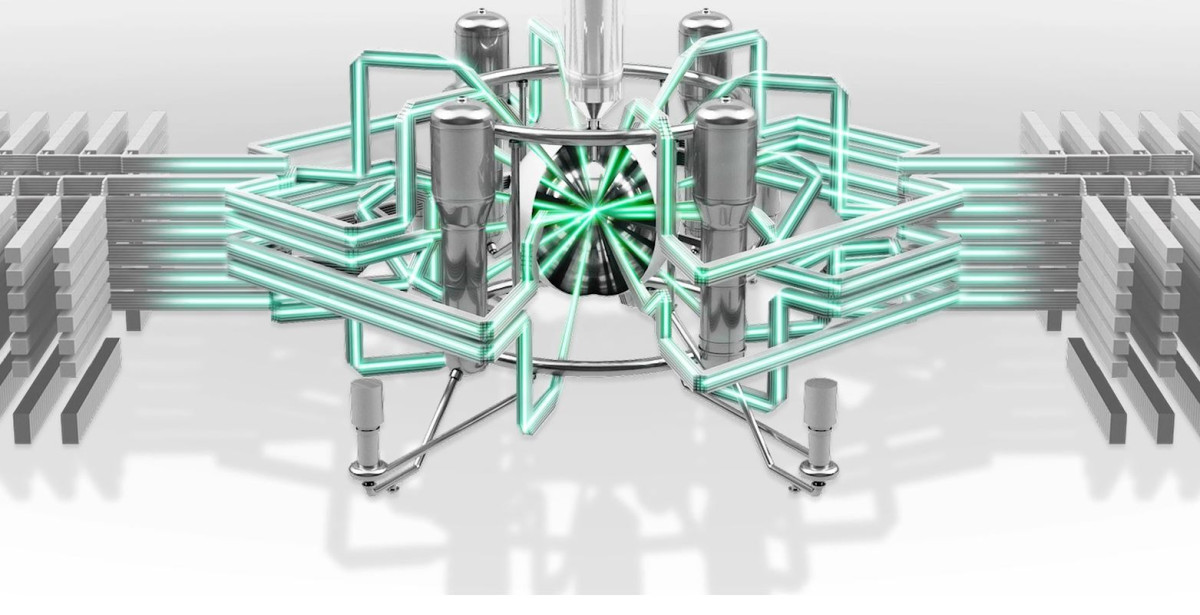Frontier climate technologies: Telling real solutions apart from wishful thinking
Experts
- BDI - Federation of German Industries
- Bellona Foundation (Norway)
- BMFTR - Federal Ministry of Research, Technology and Aerospace
- BMUKN - Federal Ministry for the Environment, Climate Action, Nature Conservation and Nuclear Safety
- BMWE - Federal Ministry for Economic Affairs and Energy
- BUND - Friends of the Earth Germany
About this dossier
In the increasingly urgent fight against climate change, countless new technologies are being touted as future solutions – from novel carbon dioxide removal methods to nuclear fusion. But what role can these frontier technologies truly play?
Media reports, political debates and talk shows often suggest that we’re still in the early stages of exploring their potential. But that's far from the truth. Researchers can clearly distinguish viable solutions from wishful thinking, and the following Q&As reflect the expert consensus. A key insight: Relevance in public debates doesn’t necessarily translate into relevance in the fight against climate change.
It’s high time scientists' insights shaped public discussions, so that policies are guided by evidence rather than hype. Our blog post Journalists must cover “zany” climate solutions – with extra care, which is based on the input of the Economist's science and technology editor Alok Jha, explains why frontier climate technologies demand urgent media attention – and how journalists can approach the topic responsibly.
Carbon capture and storage
Q&A: Carbon capture and storage - Hype or hope for a cooler planet?
Carbon capture and storage (CCS) is quickly gaining massive importance in Germany, at the EU level, and globally as an essential element of climate action. The technology sounds like a convenient solution to the climate crisis: capturing CO2 from the use of fossil fuels in power plants and factories and storing it underground. But many applications remain controversial, because of high costs, immature technology and the risk of diverting attention from immediate emission cuts. This Q&A answers the most prominent questions around CCS, based on the consensus of science.
In a nutshell: Using carbon capture and storage (CCS) for climate action
Carbon capture and storage (CCS) is seen as a crucial technology for climate action, especially in industries where emissions are very hard to avoid, such as cement production. However, it is expensive, energy-intensive, still in its infancy, and cannot yet reduce emissions to zero. In the energy sector, there are currently simpler, cheaper, and more effective climate solutions available than installing CCS in fossil fuel power plants. This factsheet sums up the most important facts about CCS.
Carbon capture essential for scaling net-zero concrete – global cement producer
Carbon capture is set to play a key role in decarbonising the cement and concrete industry, says Jan Theulen, Group Lead Carbon Capture, Utilization and Storage (CCUS) at Heidelberg Materials, one of the world's largest cement makers. The company’s strategy combines the use of biogenic waste as fuel with CO₂ capture to pave the way for climate-neutral concrete. But to scale carbon capture and storage (CCS), technical innovation alone won’t be enough — a coordinated approach to CO₂ transport and storage infrastructure is also crucial, Theulen told Clean Energy Wire in this interview.
Q&A – CCS makes comeback as Germany and the EU strive for climate neutrality
Years of protest against industry plans to use carbon capture and storage (CCS) as a lifeline for coal power have made the technology a no-go issue for many politicians in Germany, Europe and beyond. Yet, countries' goals of climate neutrality around mid-century reopened the debate on the issue of combatting CO2 emissions that are difficult to avoid, for example in cement production. Parties, including the German Greens, are realigning their official stance, and the country's former coalition government presented first policy and law drafts to pave the way for the necessary technologies. However, it failed to adopt these in parliament and the new government has said it aims to continue the efforts. This Q&A provides a brief explanation of CCS, the history of public opposition and the status quo of the debate in Germany and the EU.
Nuclear fusion

Q&A: Nuclear fusion - Hype or hope for a cooler planet?
Nuclear fusion could provide limitless, safe, climate-friendly energy - in theory. Countries such as Germany, the US, China, Japan and the UK, as well as the European Union, are investing billions of euros in developing this technology. But is it a viable strategy for achieving climate neutrality, as some proponents suggest? Or is it a harmful distraction from other methods of reducing emissions, as sceptics argue? This Q&A addresses the most significant questions surrounding nuclear fusion, based strictly on scientific consensus.
In a nutshell: Can nuclear fusion help save the climate?
Nuclear fusion holds the promise of delivering climate-friendly, safe, and virtually limitless energy. But even if the technology proves successful, it will likely come too late to play a major role in reaching climate neutrality by mid-century. Fusion still faces significant technical hurdles and is expected to remain costly, which could severely limit its use in a world powered mainly by renewables. This factsheet breaks down the key facts about nuclear fusion.
Europe must build on nuclear fusion headstart to complement renewables – startup
Nuclear fusion technology presents a huge chance for European industry, which the continent must pursue without delaying the rollout of renewable energies, says Markus Roth, co-founder of nuclear fusion startup Focused Energy. “It’s not a question of either/or. We need both”, Roth told Clean Energy Wire in this interview. He said Germany is currently moving ahead in the global race for fusion energy, and is attracting US researchers and startups who are considering emigration in the face of the US administration’s attack on science. “This is a clear opportunity for Germany and Europe that we must use,” Roth said, who insisted that Europe’s massive ITER fusion research project is inherently slow compared to competing startups.
“Now or never”: German fusion startups urge €3 billion state push for pilot plants
Germany must seize a “unique historical opportunity” to lead in nuclear fusion technology by committing three billion euros for the construction of demonstration plants, the country’s leading fusion startups said. With a view to the government’s pending fusion strategy, they argued that public support must move beyond basic research. Industrial pilot projects should be made possible by 2030 - and a first commercial plant later in the same decade. Read the article here.
Germany advances plans for world's first fusion power plant in “High-Tech Agenda”
The German government has fleshed out how it intends to build the world’s first nuclear fusion reactor in a “High-Tech Agenda”, which also sets ambitious targets for other technologies it considers key for the energy transition, such as batteries, synthetic fuels, and industrial carbon capture. A strategic, long-term "Fusion Action Plan" is due later this year, followed by a “Fusion Energy Research and Innovation Roadmap (FIRE)” in 2026. Read the article here.
Investors bet record €130mln on German fusion startup Proxima
German startup Proxima Fusion has raised 130 million euros from private investors. The record funding reflects both growing optimism that nuclear fusion will provide plentiful and clean energy in the not-too-distant future, and Europe’s progress in establishing a global research lead. Proxima will use the money to build an extremely complex magnet, which is central to its approach, and soon choose a European country for a demonstrator fusion power plant. The company’s eventual aim is to “deliver limitless, safe, clean fusion energy to the grid in the 2030s” – a timeline many observers believe is unrealistic. Read the full article here.
Direct air capture

Q&A: Direct air capture - Hype or hope for a cooler planet?
It sounds like a great promise, the solution to all climate problems: Plants that filter the greenhouse gas carbon dioxide back out of the air so that it can be stored somewhere - "artificial trees", so to speak. But how realistic is this idea? How much CO2 could actually be removed from the atmosphere using this technology? When would this be possible, how much energy will be needed, and how expensive will it be? This Q&A addresses the most important questions surrounding direct air capture, based strictly on scientific consensus.

